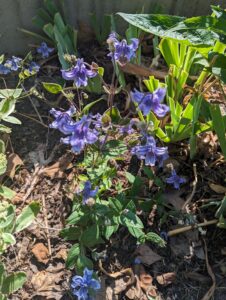 In a memorable scene from the Rogers and Hammerstein musical South Pacific, the character of Emile de Becque sings:
In a memorable scene from the Rogers and Hammerstein musical South Pacific, the character of Emile de Becque sings:
“Some enchanted evening, you may see a stranger,
You may see a stranger across a crowded room,…”
I had a similar feeling one semi-enchanted afternoon, when I saw a bush clematis across a crowded garden center. As in the song, I flew to its side—or at least its plant pallet—and made it my own.
What caused this heart-fluttering experience? The bush clematis in question was a variety named after another song, “Stand by Me”, sung with great effect by the late Bill Withers.
It stood about 24 inches above its container and was covered with bright sky-blue, bell-shaped flowers. Each one was about two inches long, with petals that were edged in lighter blue and reflexed or curled backward. Though the flowers were the main attraction, the medium green leaves, which were broadly oval-shaped, were pleasant and plenteous on the plant.
When most people think of clematis, they imagine the popular large-flowered varieties, with six-inch single or double blooms that are almost tropical in appearance. Varieties like pink-and-white ‘Nellie Moser’ and purple jackmanii bloom in late spring on arbors, columns, tuteurs and lampposts in neighborhoods across the country. Bush clematis are different. Some, like ‘Stand by Me’ are non-vining, meaning they form loose clumps. Others sprawl and can be grown like climbers if the shoots are tied to supports. Those clematis can also be left to their own devices to sprawl among other plants in beds and borders. Most of the non-vining types have smaller flowers than those of the vining clematis, but make up for that with abundant production. Bush varieties are also very useful in medium to large containers.
A species plant is usually identified by generic, species and—often–varietal names, as in Geranium macrorrhizum ‘Bevans Variety’. If a plant tag shows only the generic and varietal names, either the merchandiser is lazy, or, more likely, the plant in question is a hybrid. A hybrid can be either an intraspecies type, meaning that it is the offspring of crosses between or among varieties of the same species, or an interspecies hybrid, resulting from crosses between or among different species. ‘Stand by Me’ is an interspecies hybrid, bred by breeder Hans Hansen, working for Walters Gardens, a wholesale nursery in Michigan.
To arrive at ‘Stand by Me’, Hansen crossed a couple of non-vining species: North American native, Clematis fremontii, also known as “Fremont’s clematis” or “Fremont’s Crow’s Foot”: and a Eurasian species, Clematis integrifolia, also known as “bush clematis”, “solitary clematis” or more poetically, “Solitary Virgin’s Bower”. The fremontii species features white or purple flowers, while the integrifolia type produces blue flowers. Both sport blooms that nod, rather than facing upright, like those of the large-flowered clematis. Integrifolia clematis must be good companions with winning qualities, because the species has been hybridized frequently with other clematis species to produce excellent plants.
‘Stand by Me’ grows between two and three feet tall, depending on soil and climate conditions. In the spring, the emerging leaves are bronze underneath, but green up as the growing season progresses. After the departure of the winsome flowers, the plants form fluffy white seed heads that are quite decorative on their own. The variety can be massed for dramatic effect, or used as single specimens in beds, borders or containers. One grower recommends them as companion plants in rose gardens; another suggests that they be used to flank walkways.
The cultural rule for large-flowered clematis—“heads in the sun and feet in the shade” holds true for ‘Stand by Me’ and its small-flowered relatives. You can keep the “feet in the shade” by mulching well around the plants. Pollinators will be drawn to it and deer—allegedly—will avoid it.
I will withhold my judgment on the latter until my ‘Stand by Me’ has been in the ground for awhile. Lately the deer have stuck to expensive hostas in my yard, but the rabbits are not as selective.
You may be able to buy ‘Stand by Me’ at garden centers now, and may even obtain one at a bargain price. If not, order from one of the many online suppliers that offer the variety for the fall planting season.
